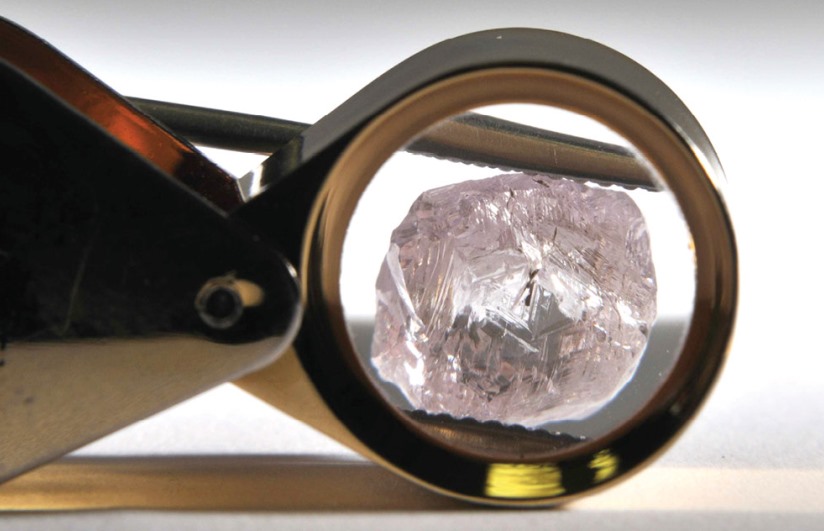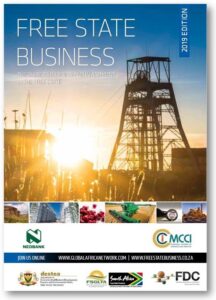Petra Diamonds’ Koffiefontein mine is on the western edge of the province, about 80 km from Kimberley. The mine is regarded as a low-grade deposit, but the diamonds produced are of high value. White stones of excellent quality are produced, and fancy pink diamonds (pictured) are sometimes found.
The company’s expansion plan led to increased production in the 2018 financial year of 52 537 carats, up from 51 173 carats in 2017. Expansion will increase, and the plan is to mine at Koffiefontein until 2031. Petra has seven mines in South Africa. The Star mine, in which Petra is in partnership with Sedibeng Mining, is the other Free State asset.
De Beers Consolidated Mines decided in 2018 to close their Voorspoed Mine in the province. The National Department of Mineral Resources is trying to find a buyer for the mine, but De Beers has already run a bidding process and found no suitable buyer. The company has started the complicated business of closing down the mine, which includes offering training programmes for employees for possible future employment in other industries.
The Lace mine near Kroonstad went into business rescue in November 2016 after heavy rains affected operations. In May 2017 owner DiamondCorp put its listed holding company into administration. The primary lender was the Industrial Development Corporation (IDC).
Diamonds, coal and gold are the three main minerals found in the Free State, but the decline of gold mining is a cause for concern. Several summits and a Mining Indaba have focussed on what kind of economic activity can replace gold mining.
The mining sector makes up 11% of provincial GDP. A minerals beneficiation strategy has been developed because this is a key area for potential growth.
In 2016, De Beers, the South African government and the South African diamond cutting industry launched a project to encourage diamond beneficiators. Among the first companies involved are Thoko’s Diamonds, African Diamonds, Nungu Diamonds and Kwame Diamonds. In 2017 some of the newly qualified cutters and polishers attended the Hong Kong Show.
Gold
AngloGold Ashanti has sold most of its Vaal River Complex mines to Harmony Gold Mining for $300-million. Most of the mines are in the North West Province, but Great Noligwa and Kopanang mines are in the Free State. The complex includes one uranium plant, four gold plants and one sulphuric acid plant.
These assets will increase Harmony’s underground resource base in South Africa by nearly 40%. Most of Harmony’s operations, including a tailings treatment plant, are in the Free State. The other mines are Tshipong and Phakisa (near Odendaalsrus), Virginia, Target (near Allanridge), Masimong (Riebeeckstad), Joel (near Theunissen) and Bambanani at Welkom. Phakisa has mineral reserves of just over five-million ounces of gold and Harmony has invested heavily in the project.
The other buyer from AngloGold Ashanti was Heaven-Sent. The Chinese company, which controls the Tau Lekoa mine through Village Main Reef, bought the Kopanang mine and associated assets for R100-million. Another Chinese company, Taung Gold, runs the Jeanette mine near Welkom.
Sibanye Gold came into existence as a result of the unbundling of Gold Fields, but it has now been rebranded as Sibanye Stillwater because of the purchase of a platinum and palladium mine in the US of that name. The company is responsible for the Beatrix mine in the Free State but most of its gold assets are in Gauteng.
Gold mines in the Free State also supply a substantial portion of the total silver produced in the country, and large concentrations of uranium occurring in the gold-bearing conglomerates of the goldfields are extracted as a by-product.
Coal
Coal is mostly found in the northern part of the Free State and the gold fields, which form part of the Witwatersrand Basin, stretch from north of Welkom to south of Virginia.
The Sigma-Mookraal mine is run by Sasol Mining and has the capacity to supply Sasol Infrachem in Sasolburg with two-million tons of coal per year.
Seriti Resources has purchased the New Vaal Colliery from Anglo American. Together with two other mines in Mpumalanga Province, Seriti paid R2.3-billion. New Vaal is in the middle of a triangle of three towns that play an important part in industrial production: Vereeniging, Sasolburg and Vanderbijlpark. The mine employs more than 900 people and supplies about 15-million metric tons of coal to Eskom’s Lethabo power station annually.
Other minerals
By-products of gold operations (uranium, silver, platinum group metals and sulphuric acid) and bentonite are also found in the province.
Among the companies running large quarries in the Free State are Lafarge, Raumix and Corobrik. Sand, stone aggregate, gypsum and granite are found at various sites throughout the province. Limestone and calcrete occur in the western Free State where salt is also panned. Production is concentrated around the Florisbad salt pan, north-west of Bloemfontein. The Ocean Bentonite mine near Koppies in the north-west Free State is one of only two in the country.
Online resources
- Geological Society of South Africa: www.gssa.org.za
- Minerals Council of South Africa: www.mineralscouncil.org.za
- Mining Qualifications Authority: www.mqa.org.za
- National Department of Mineral Resources: www.dmr.gov.za
- South African Mining Development Association: www.samda.co.za
Article source: Mining sector overview in 2019 edition of Free State Business, the guide to business and investment in the Free State Province.




